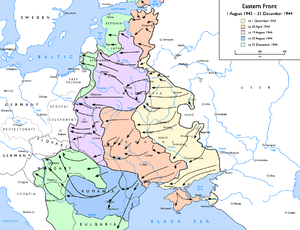
The history of Latvia began around 9000 BC with the end of the last glacial period in northern Europe. Ancient Baltic peoples arrived in the area during the second millennium BC, and four distinct tribal realms in Latvia's territory were identifiable towards the end of the first millennium AD. Latvia's principal river Daugava, was at the head of an important trade route from the Baltic region through Russia into southern Europe and the Middle East that was used by the Vikings and later Nordic and German traders.

Courland is one of the Historical Latvian Lands in western Latvia. Courland's largest city is Liepāja, which is the third largest city in Latvia. The regions of Semigallia and Selonia are sometimes considered as part of Courland as they were formerly held by the same duke.
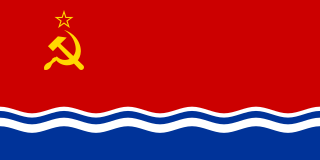
The Latvian Soviet Socialist Republic was de facto one of the constituent republics of the Soviet Union between 1940–1941 and 1944–1990.
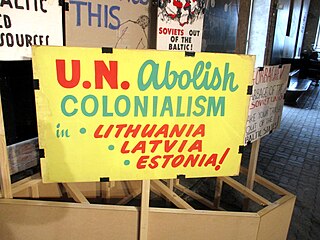
The occupation of the Baltic states was a period of annexation of Estonia, Latvia and Lithuania begun by the Soviet Union in 1940, continued for three years by Nazi Germany after it invaded the Soviet Union in 1941, and finally resumed by the Soviet Union until its dissolution in 1991.
Army Group Courland was a German Army Group on the Eastern Front. It was created from remnants of the Army Group North, isolated in the Courland Peninsula by the advancing Soviet Army forces during the 1944 Baltic Offensive of the Second World War. The army group remained isolated in the Courland Pocket until the end of World War II in Europe. All units of the Army Group were ordered to surrender by the capitulated Wehrmacht command on 8 May 1945.

The Battle of Narva was a World War II military campaign, lasting from 2 February to 10 August 1944, in which the German Army Detachment "Narwa" and the Soviet Leningrad Front fought for possession of the strategically important Narva Isthmus.

The Baltic offensive, also known as the Baltic strategic offensive, was the military campaign between the northern Fronts of the Red Army and the German Army Group North in the Baltic States during the autumn of 1944. The result of the series of battles was the isolation and encirclement of the Army Group North in the Courland Pocket and Soviet re-occupation of the Baltic States. In Soviet propaganda, this offensive was listed as one of Stalin's ten blows.

The military occupation of Latvia by Nazi Germany was completed on 10 July 1941, by Germany's armed forces. Initially, the territory of Latvia was under the military administration of Army Group North, but on 25 July 1941, Latvia was incorporated as Generalbezirk Lettland, subordinated to Reichskommissariat Ostland, an administrative subdivision of Nazi Germany. Anyone not racially acceptable or who opposed the German occupation, as well as those who had cooperated with the Soviet Union, was killed or sent to concentration camps in accordance with the Nazi Generalplan Ost.

Jānis Balodis was an army general, Commander-in-Chief of the Armed Forces of Latvia (1919–1921), Minister of War (1931–1940), and a politician who was one of the principal figures during the Latvian War of Independence and the dictatorship of Kārlis Ulmanis, when he was officially the number two of the regime as the Minister of War, Deputy Prime Minister and Vice President.
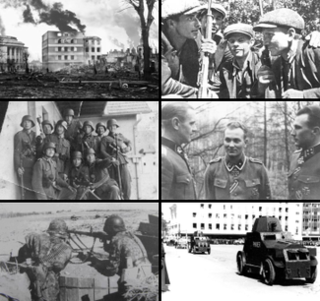
Estonia declared neutrality at the outbreak of World War II (1939–1945), but the country was repeatedly contested, invaded and occupied, first by the Soviet Union in 1940, then by Nazi Germany in 1941, and ultimately reinvaded and reoccupied in 1944 by the Soviet Union.
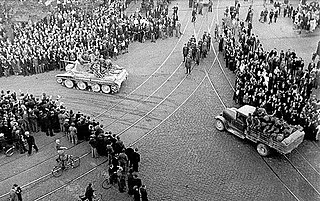
The Soviet occupation of Latvia in 1940 refers to the military occupation of the Republic of Latvia by the Soviet Union under the provisions of the 1939 Molotov–Ribbentrop Pact with Nazi Germany and its Secret Additional Protocol signed in August 1939. The occupation took place according to the European Court of Human Rights, the Government of Latvia, the United States Department of State, and the European Union. In 1989, the USSR also condemned the 1939 secret protocol between Nazi Germany and herself that had led to the invasion and occupation of the three Baltic countries, including Latvia.

Operation Doppelkopf and the following Operation Cäsar were German counter-offensives on the Eastern Front in the late summer of 1944 in the aftermath of the major Soviet advance in Operation Bagration with the aim of restoring a coherent front between Army Group North and Army Group Centre. The operation's codename was a reference to the German card game Doppelkopf.
The Šiauliai offensive was an operation of the Soviet forces of the 1st Baltic Front, commanded by General Hovhannes Bagramyan, conducted from 5 July to 29 August 1944, during the Second World War. It was part of the third phase of the Belorussian strategic offensive operation, and drove German troops from much of Lithuania, with the main tactical objective of the city of Šiauliai.
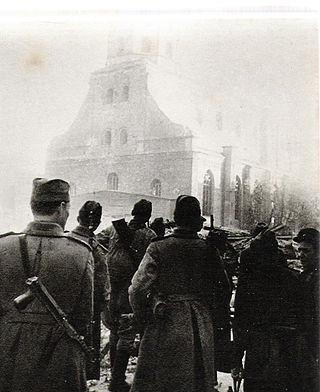
The Riga offensive was part of the larger Baltic offensive on the Eastern Front during World War II. It took place late in 1944, and drove German forces from the city of Riga.
The Tallinn offensive was a strategic offensive by the Red Army's 2nd Shock and 8th armies and the Baltic Fleet against the German Army Detachment Narwa and Estonian units in mainland Estonia on the Eastern Front of World War II on 17–26 September 1944. Its German counterpart was the abandonment of the Estonian territory in a retreat codenamed Operation Aster.

The Soviet re-occupation of Latvia in 1944 refers to the military occupation of Latvia by the Soviet Union in 1944. During World War II Latvia was first occupied by the Soviet Union in June 1940, then was occupied by Nazi Germany in 1941–1944, and after which it was re-occupied by the Soviet Union.

The Soviet Union issued an ultimatum to Lithuania before midnight of June 14, 1940. The Soviets, using a formal pretext, demanded that an unspecified number of Soviet soldiers be allowed to enter the Lithuanian territory and that a new pro-Soviet government be formed. The ultimatum and subsequent incorporation of Lithuania into the Soviet Union stemmed from the division of Eastern Europe into the German and Soviet spheres of influence agreed in the Molotov–Ribbentrop Pact of August 1939. Lithuania, along with Latvia and Estonia, fell into the Soviet sphere. According to the Soviet–Lithuanian Mutual Assistance Treaty of October 1939, Lithuania agreed to allow some 20,000 Soviets troops to be stationed at bases within Lithuania in exchange for receiving a portion of the Vilnius Region. Further Soviet actions to establish its dominance in its sphere of influence were delayed by the Winter War with Finland and resumed in spring 1940 when Germany was making rapid advances in western Europe. Despite the threat to the country's independence, Lithuanian authorities did little to plan for contingencies and were unprepared for the ultimatum.
The timeline of the occupation of the Baltic states lists key events in the military occupation of the three countries – Estonia, Latvia and Lithuania – by the Soviet Union and by Nazi Germany during World War II.

The background of the occupation of the Baltic states covers the period before the first Soviet occupation on 14 June 1940, stretching from independence in 1918 to the Soviet ultimatums in 1939–1940. Lithuania, Latvia, and Estonia gained independence in the aftermath of the Russian revolutions of 1917 and the German occupation which in the Baltic countries lasted until the end of World War I in November 1918. All three countries signed non-aggression treaties with the Soviet Union in the 1920s and 1930s. Despite the treaties, in the aftermath of the 1939 German–Soviet pact, Estonia, Latvia and Lithuania were occupied, and thereafter forcibly incorporated into the Soviet Union, in 1940.

The Soviet occupation of the Baltic states covers the period from the Soviet–Baltic mutual assistance pacts in 1939, to their invasion and annexation in 1940, to the mass deportations of 1941.


